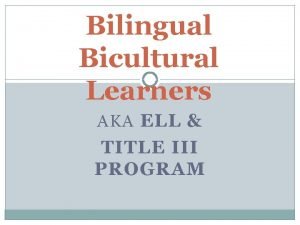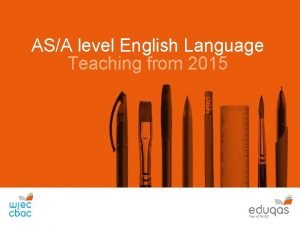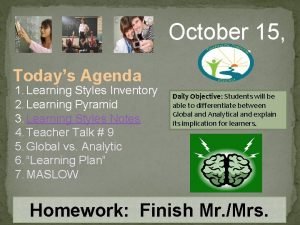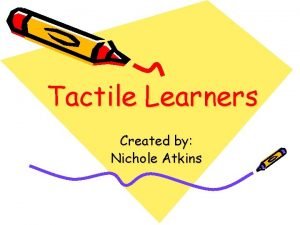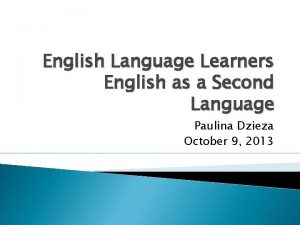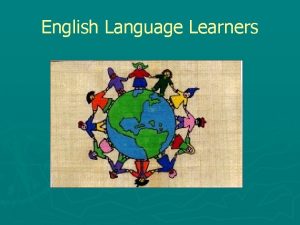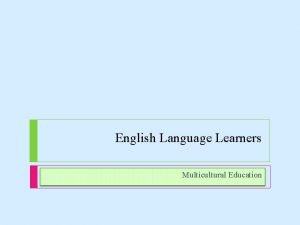Educational Challenges of English Language Learners Educational Challenges








- Slides: 8

Educational Challenges of English Language Learners

Educational Challenges of English Language Learners: An Overview of the Paper � The purpose of the topical research paper is to bring awareness and to shed light on the various challenges facing English language learners in American education today. � Challenges presented: Few regular education teachers are adequately equipped to integrate and properly instruct English language learners in mainstream classes. Establishing ESL programs that cater to the individual needs of the ELL students and testing this population’s proficiency in English and content prove to be a challenge. The problems with testing this population’s proficiency in English often results in misplacement of English language learners into special education classes, low academic scores, high drop out rates and low graduation rates. § Finally, the paper finishes by providing insight to various means for how school counselors can positively impact the educational process for English language learners.

Educational Challenges of English Language Learners: Background Information � “English language learners are the fastest-growing student population group in our schools. Providing them with high-quality services and programs is an important investment in America’s future” (National Education Association, 2008). � Data from 2007 -08 show that this population represented more than 10 percent of students enrolled in kindergarten through twelfth grade, which accounted for over five million ELL students (Calderón, Slavin, & Sánchez, 2011). � Although as many as 75 percent of ELLs are Spanish-speaking, English language learners embody over 400 languages (Xu & Drame, 2008). � A common misconception about English language learners is that the majority are immigrants or children of immigrants; however, more than half are second or third generation Americans (NEA, 2008).

Educational Challenges of English Language Learners: Challenge #1: Poor Teacher Education � Reports from 2000 showed that while only 13 percent of teachers had received guidance in teaching ELL students in a classroom setting, approximately 41 percent of teachers were required to teach these students (Calderón et al. , 2011). � Many of these instructors: Do not understand the difficulty of learning a new language, May not be able to distinguish the proficiencies of the ELL students which could prohibit them from relaying concerns about the students’ education May be unable to effectively communicate with their ELL students about their progress in the classroom and tasks required of them (Verdugo & Flores, 2007).

Educational Challenges of English Language Learners: Challenge #2: ESL Programs � Elementary School - ELL children are often taken out of class for 30 minutes for ESL instruction and for the remainder of the day, are required to sit in English led classes with other students � Middle & High School – ELLs are typically assigned to an ESL program, which is geared toward assisting students with reaching an English proficiency level high enough to become integrated into mainstream classes with regular education teachers. � ESL Program Challenges: Struggle to determine whether bilingual instruction or maintaining an English only approach is more successful (Calderón et al. , 2011). ELLs come from a variety of backgrounds and cultures and have different needs, aptitudes, skills, abilities, strengths and weaknesses, levels of English knowledge and proficiency, and many other traits and are group into one ESL subgroup

Educational Challenges of English Language Learners: Challenge #3: Testing ELL Students � ELL students are often required to be tested in content knowledge of subjects like math and reading in English, as required by law, before they reach a high level of English proficiency (NEA, 2008). � ELLs, who have been a part of an English learning program for at least one year, are included with all other students in large, standardized evaluations as instructed by federal legislation (Verdugo & Flores, 2007). � Approximately 27 percent of elementary school ELL students and almost 50 percent of secondary students were more likely to be placed in special education classes (Xu & Drame, 2008). � The inaccurate and inconsistent parameters to which English language learners are subject combined with the challenges of educating ELL students in mainstream classrooms result in low test scores, achievement gaps, high dropout, and low graduation rates (Xu & Drame, 2008).

Educational Challenges of English Language Learners: The Role of School Counselors (my field of study) � The school counselor should be the English language learner’s advocate which is of utmost importance once its taken into account that often, the parents of an ELL student are not able to fully understand the United States’ educational system and therefore may be unsuccessful in their attempts to negotiate with the school (Wassell et al. , 2010). � They could also attempt to reconcile opposing expectations between the school and the home for the English language learner. � Another aspect of advocating for ELL students is working with the administration in the district to improve testing and provide accommodations as much as possible. � Lastly, advocating for the student also means encouraging education and training in professional development associated with educating ELL students for regular education teachers.

Educational Challenges of English Language Learners: Further Education � Further Education on this issue: In-service workshops dedicated to instructing educators on how to make their classrooms a successful learning environment for both native Englishspeakers and ELLs. § Benefits of Additional Education: o Learn tactical aspects of integrating English language learners into mainstream classes o Learn about the emotional element of education for the ELL students (Wassell et al. , 2010). o The greater a teacher understands the fear that many non-native English speakers have for speaking English in public, the better a teacher can empathize with a student.

